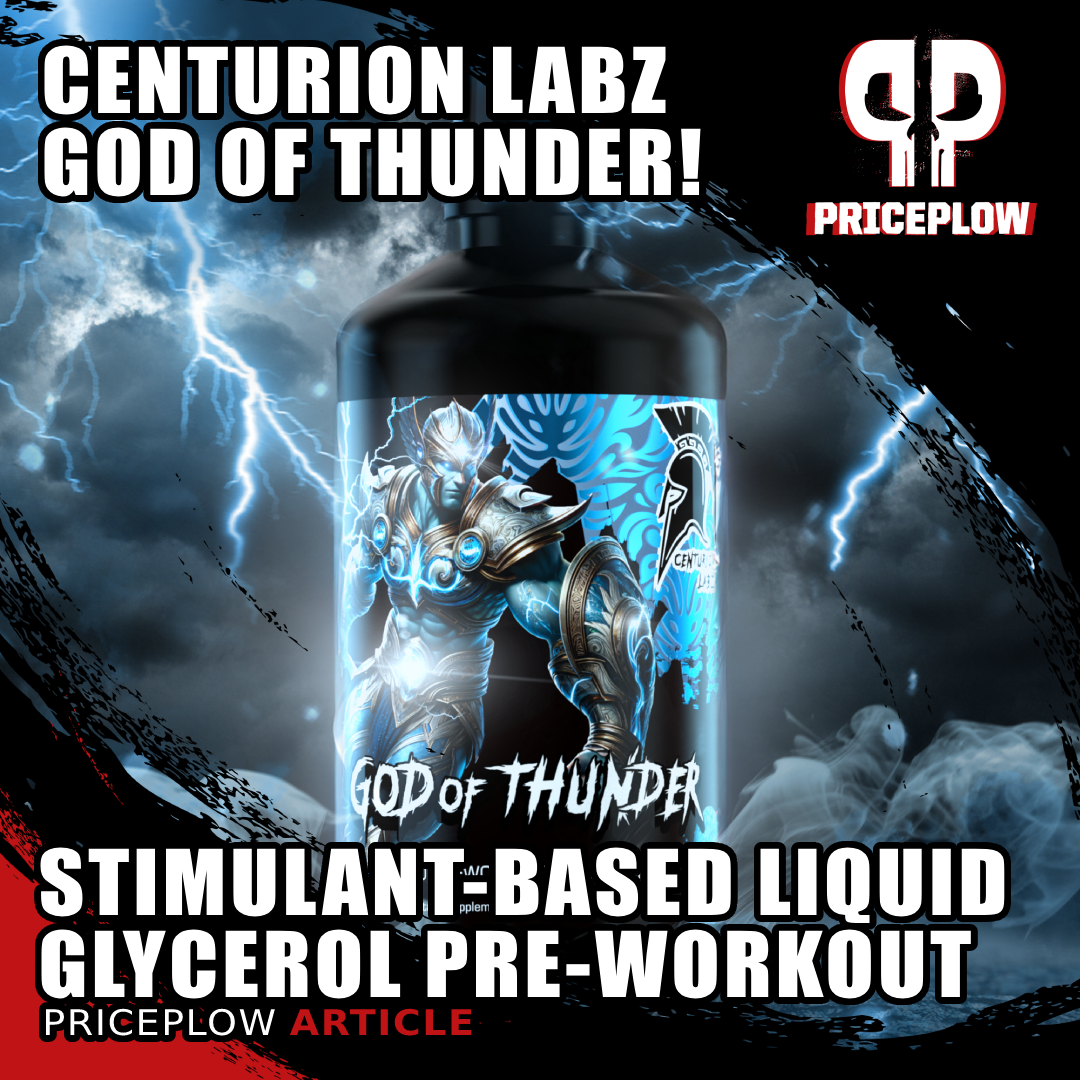
Centurion Labz's new God of Thunder formula isn't just liquid glycerol; it's a groundbreaking pre-workout suspension. Packing 12 grams of glycerol powder into 8 grams of liquid, they've cracked the code on adding stimulants like ~355 mg of caffeine and synephrine into the mix.
The supplement industry often mirrors an arms race when it comes to bringing interesting new products to market. One of the latest frontiers? Liquid glycerol.
Glycerol is great for getting a volumizing pump. By inducing a state of hyperhydration in the cells, your muscles swell up, your thermal resistance is improved, you can get some great performance gains, and recovery times drop. This issue is that it takes a lot of glycerol to have an effect – we're several grams worth, which is a lot when in powdered form.
Enter liquid glycerol. We've seen a slew of liquid glycerol supplements hit the market these past few years, with some unique add-on ingredients. Yet they've all been stimulant-free... until now.
Centurion Labz decided it was time to put their own spin on liquid glycerol -- with stimulants!
Centurion Labz God of Thunder: A STIMULANT-Based Liquid Glycerol Pre-Workout!
Centurion Labz is a brand known for its aggressiveness. They have not shied away from including novel and exciting ingredients in their formulas. Recently, they've been going through their collection and streamlining – ensuring their formulas pack a punch with as little filler as possible.
Their new God of Thunder formula is not just any liquid glycerol. It's a liquid pre-workout suspension that packs in the equivalent of 12 grams of glycerol powder into 8 grams of liquid. More importantly, they're the first brand to crack the code on including stimulant ingredients in a liquid glycerol supplement! It's notoriously difficult to yield consistent dosages of ingredients like caffeine due to the chemical consistency complexities of liquid glycerol. But thanks to their background in chemistry and an excellent manufacturer, Centurion has found a way.
355mg caffeine, synephrine, theobromine, alpha-yohimbine, and more!
With ~355 milligrams of caffeine, synephrine, theobromine, alpha-yohimbine, and more, God of Thunder will have you feeling like Zeus executing justice upon the world from Mt. Olympus.
We're going to dive into a little summary on how God of Thunder works, but first, let's check Priceplow for good Centurion Labz deals, and check out our video review of the game-changing formula:
Centurion Labz God of Thunder – Deals and Price Drop Alerts
Get Price Alerts
No spam, no scams.
Disclosure: PricePlow relies on pricing from stores with which we have a business relationship. We work hard to keep pricing current, but you may find a better offer.
Posts are sponsored in part by the retailers and/or brands listed on this page.
Centurion Labz God of Thunder Ingredients
God of Thunder comes in a 32 ounce bottle. Each serving is 4 tablespoons (or roughly 1.33 capfuls) and contains the following ingredients:
-
Glycerol – 8,000mg
Glycerol is a sugar-alcohol that acts as a byproduct of your body's metabolism of fatty acids and glucose.[1,2] It's essential for gluconeogenesis,[3] a process where your liver synthesizes glucose from non-sugar substrates like proteins. This mechanism ensures your body can maintain blood sugar levels even when carbohydrate intake is low.
Glycerol plays a crucial role in regulating the water balance of your cells by influencing extracellular osmotic pressure.[4] This process of osmosis enables water to move from areas of high solute concentration to those with lower concentrations, and by increasing osmotic pressure, glycerol helps draw more water into your cells.[5]
This increased water intake into the cells leads to a state of cellular hyperhydration, offering several athletic benefits. Hyperhydrated cells can resist heat better, have improved nutrient availability, and support enhanced performance and faster recovery.[4]
Improved water retention → less urination!
There are some other really cool things that higher-dosed glycerol can do. One thing we love to talk about is how research studies have shown athletes urinating less![6,7] So not only does this mean you keep your water for the hydration benefits described above, but you have fewer annoying trips to the bathroom, too!
-
Citrulline Malate – 1,500mg
L-citrulline has become a staple in the sports nutrition industry, widely recognized for its role as a nitric oxide (NO) boosting supplement. As a conditionally essential amino acid, L-citrulline supports the production of L-arginine, the direct precursor to nitric oxide.[8,9] While the body can produce some citrulline naturally, during periods of intense physical exertion or stress, supplementation becomes necessary to meet the increased demand.
The benefits of increased nitric oxide levels are significant for athletic performance. Nitric oxide promotes vasodilation, which relaxes the smooth muscles lining the arteries, leading to an expansion in their diameter.[10,11] This process reduces blood pressure and heart rate, easing the cardiovascular system's workload. More importantly, vasodilation enhances circulation, improving the delivery of nutrients and oxygen to tissues while facilitating the removal of waste products.[12,13]
Despite citrulline being one step removed from nitric oxide production, its supplementation is more effective than directly taking arginine due to its superior bioavailability.[14-19] Research has shown that citrulline not only boosts power output[20] and endurance[21] but also reduces exercise-induced soreness[21] and supports muscle growth.[22]
Obviously this isn't a massive dose, but it's what would fit in the bottle and serving size. We can't make any claims on such a dose -- we'd need about twice as much to start seeing clinically-supported benefits -- but we'll still take anything we can get. The same goes for the next ingredient.
-
Beta Alanine – 500mg
Beta-alanine is responsible for the class tingling sensation in pre-workouts. While users might appreciate the temporary tingling as a sign that the supplement is working, the inclusion of beta-alanine in pre-workouts serves a more important purpose. Beta-alanine increases intramuscular carnosine levels, which helps buffer lactic acid buildup during intense exercise,[23,24] thereby reducing muscle fatigue and improving endurance.
Research supports beta-alanine's effectiveness in enhancing performance, particularly in exercises lasting from 30 seconds to 10 minutes.[25] Two significant meta-analyses highlight its benefits across various sports, with studies showing improved endurance and reduced lactic acid accumulation.[25,26]
However, those doses were at 3.2 grams per day, and this is not at that level. In a liquid glycerol, this was what could fit in. So would you rather have 500 milligrams or none? We'll take the 500 milligrams -- just realize that if you want clinically-supported benefits, you'll need to add another couple of grams or so elsewhere in your day (most studies spread the doses out, anyway).
-
Alpha GPC – 300mg
Alpha-GPC, a phospholipid rich in choline,[27] is a key ingredient that supports the body's production of acetylcholine,[28] an essential neurotransmitter involved in brain function and muscle control.[29] Unlike other forms of choline, Alpha-GPC is more effective in boosting acetylcholine levels due to its easier cellular absorption.[30] By elevating acetylcholine levels, Alpha-GPC not only improves mental clarity and focus[31-33] but also supports long-term cognitive health.[34]
In addition to its cognitive benefits, alpha-GPC has been shown to enhance physical performance by increasing strength, power, and possibly even growth hormone levels. Studies have demonstrated that alpha-GPC supplementation can lead to significant improvements in strength, particularly in exercises like bench presses and mid-thigh pulls.[35] These effects make it popular in pre-workout supplements, it's not just a focus-enhancer.
Now the fun starts:
-
Caffeine Anhydrous – 300mg (of 355mg total caffeine yield)
Caffeine suspended in a glycerol?! You bet!
Caffeine is a powerful methylxanthine stimulant that can cross the blood-brain barrier,[36] significantly impacting brain function and the central nervous system (CNS). Known for boosting mood, improving focus, and increasing wakefulness, caffeine works by blocking adenosine receptors, which helps fight fatigue.[37,38] Additionally, caffeine enhances cellular metabolism through phosphodiesterase inhibition, which increases cyclic adenosine monophosphate (cAMP) levels,[37-40] a molecule that prompts cells to generate more energy. This mechanism makes caffeine effective not only for increasing alertness but also for enhancing physical performance.
Caffeine is also recognized for its fat-burning properties, as it can directly increase the body's rate of lipolysis, leading to faster fat metabolism.[41,42] Studies show that caffeine supplementation can enhance athletic performance in various areas, including strength, speed, power, and endurance.[37,39,41] It also offers nootropic benefits by improving attention, vigilance, and working memory while reducing reaction times.[43-45]
At this point, we expect you to know what caffeine can do for you -- the question is how you dose it. There's more dicaffeine malate below, so God of Thunder has ~355 milligrams caffeine in 1.33 capfuls (four tablespoons), so if you take a capful, you'll be under that dose, which is a safe start for everyone.
-
Theobromine – 200mg
Theobromine is commonly included in pre-workouts and fat burners due to its ability to increase energy and suppress appetite.[46,47] Research indicates that theobromine operates similarly to caffeine by inhibiting both phosphodiesterase and adenosine,[46] which contributes to its energizing effects.
Despite their similar mechanisms, theobromine and caffeine differ in their stimulatory effects due to their different half-lives,[46] with theobromine metabolizing more slowly. This slower metabolism theoretically allows for sustained energy levels when combined with caffeine. Additionally, theobromine offers extra health benefits, including anti-inflammatory, antitumoral, and cardioprotective properties, making it a valuable component in energy-boosting supplements.[46]
-
Di-Caffeine Malate – 75mg (yields 55 of 355mg total caffeine yield)
Di-caffeine malate is a form of caffeine bound to malic acid, which takes slightly longer to metabolize, resulting in a more sustained energy release.
This brings us to 355 milligrams of total caffeine in the four tablespoon serving size -- if that's too much for you, then don't use the full 1.33 cap serving!
-
Synephrine HCl – 75mg
Synephrine is an alkaloid known for its ability to boost metabolic rate through beta-3 adrenoceptor agonism, which not only speeds up metabolism but also reduces blood glucose by stimulating insulin secretion.[48] This dual action helps promote fat burning for energy,[49] with studies indicating that synephrine supplementation can increase daily caloric expenditure by up to 183 calories per day.[50]
In addition to directly increasing calorie burn, synephrine also indirectly enhances metabolism by improving power output and exercise volume through ergogenic effects.[50] Although it shares some mechanisms with the stimulant ephedrine, synephrine is much less taxing on the cardiovascular system,[48,51] making it a safer alternative for those looking to enhance their metabolic rate and fat-burning potential.
This, too, is a large dose, sure to provide a high-energy effect. Again, most users will want to start at a capful or less.
-
S7 – 50mg
Studies have shown that S7, a blend of various herbal extracts, can significantly increase bioavailable nitric oxide by 230%,[52] making it highly effective for enhancing blood flow and vascular health. The blend includes a variety of botanical extracts typically associated with antioxidant benefits but also plays a crucial role in supporting nitric oxide levels.
The ingredients in the S7 blend contribute to its overall effectiveness in various ways. Green coffee bean extract, with its high levels of chlorogenic acid,[53] offers anti-inflammatory and anti-hypertensive benefits,[54,55] while Green Tea Extract, rich in catechins[56] like EGCG, helps boost fat burning and manage weight.[57,58] Other ingredients like turmeric extract, tart cherry extract, blueberry, broccoli extract, and kale provide additional anti-inflammatory, vascular health, and NO-enhancing benefits.[59-67]
-
Rauwolfia Vomitoria Extract (std. For Alpha Yohimbine) – 1.5mg
God of Thunder isn't done with the stimulants yet!
Rauwolscine is an alkaloid that closely resembles yohimbine, often earning it the nickname "alpha-yohimbine." Like yohimbine, rauwolscine interacts with your body's adrenergic receptors by antagonizing the alpha-2 adrenergic receptors. This interaction leads to several desirable physiological effects, such as increased energy expenditure,[68] reduced appetite,[69] and accelerated fat loss.[70]
Additionally, rauwolscine offers cognitive benefits by stimulating your body's sympathetic nervous system, which can significantly enhance focus and mental clarity.[71]
1.5 milligrams is enough to seriously feel, without most users getting completely overwhelmed. But again, you'll probably want to start at around one capful.
What a powerful, unique supplement -- this is unlike anything we've ever seen. Retailers have recently been enjoying the liquid glycerol addons for pumps, but this is on a whole new level.
All Centurion Labz God of Thunder flavors
Check out our up-to-date list of God of Thunder flavors below:
A Unique Formula of Power
A hat tip to the chemists at Centurion Labz and their manufacturer for making this one happen!
Glycerol is one of the most efficacious ingredients for inducing mega pumps and hyperhydration. Brands have been racking their brains trying to find good ways of efficiently delivering enough glycerol to glean benefits, and thus liquid glycerol was born.
Centurion has taken massive ground in this war by making it feasible to include stimulants in glycerol mixes, which has been a tall order. As such, God of Thunder is a game changer in this category. A weapon of mass construction, if you will.
Centurion Labz God of Thunder – Deals and Price Drop Alerts
Get Price Alerts
No spam, no scams.
Disclosure: PricePlow relies on pricing from stores with which we have a business relationship. We work hard to keep pricing current, but you may find a better offer.
Posts are sponsored in part by the retailers and/or brands listed on this page.

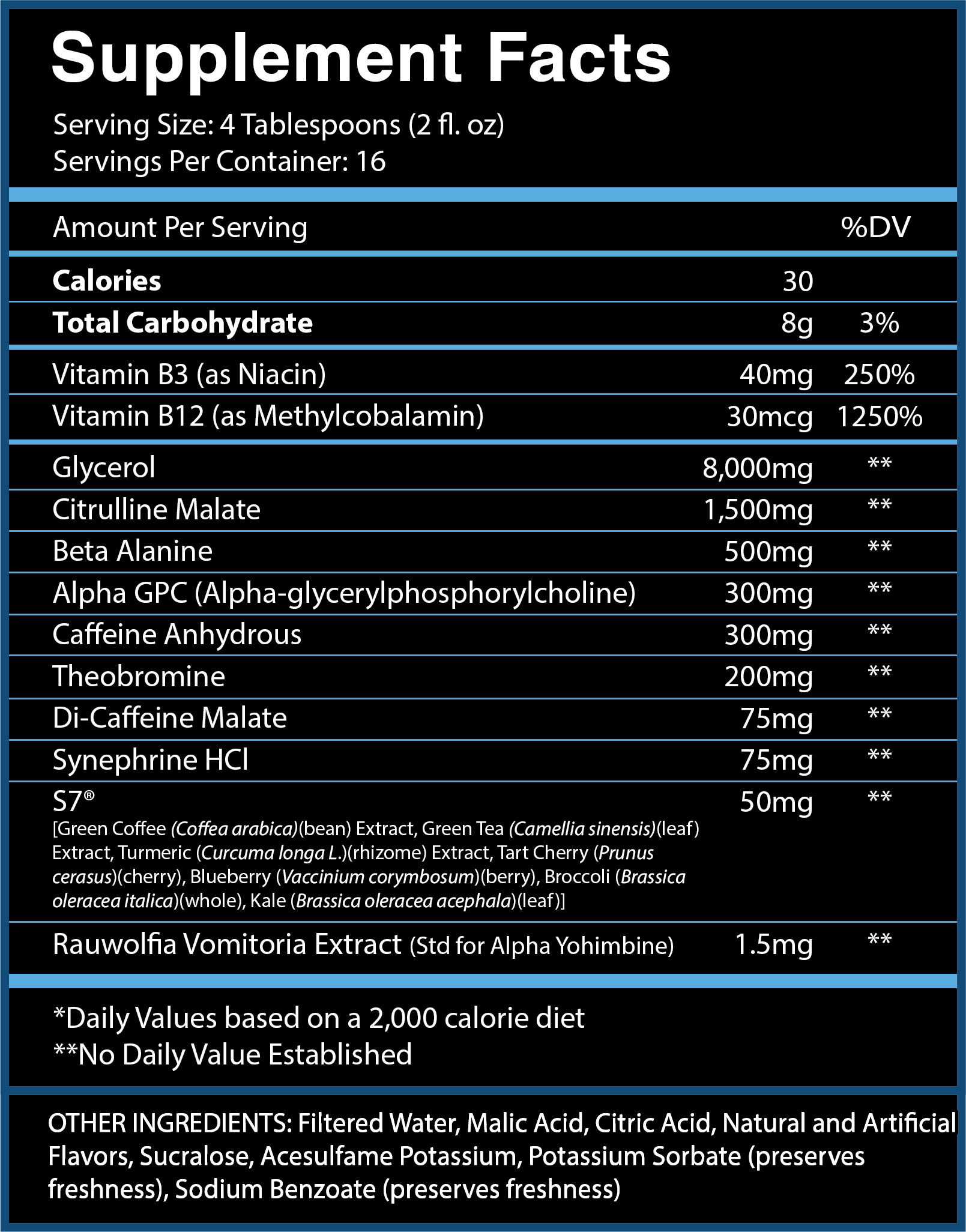

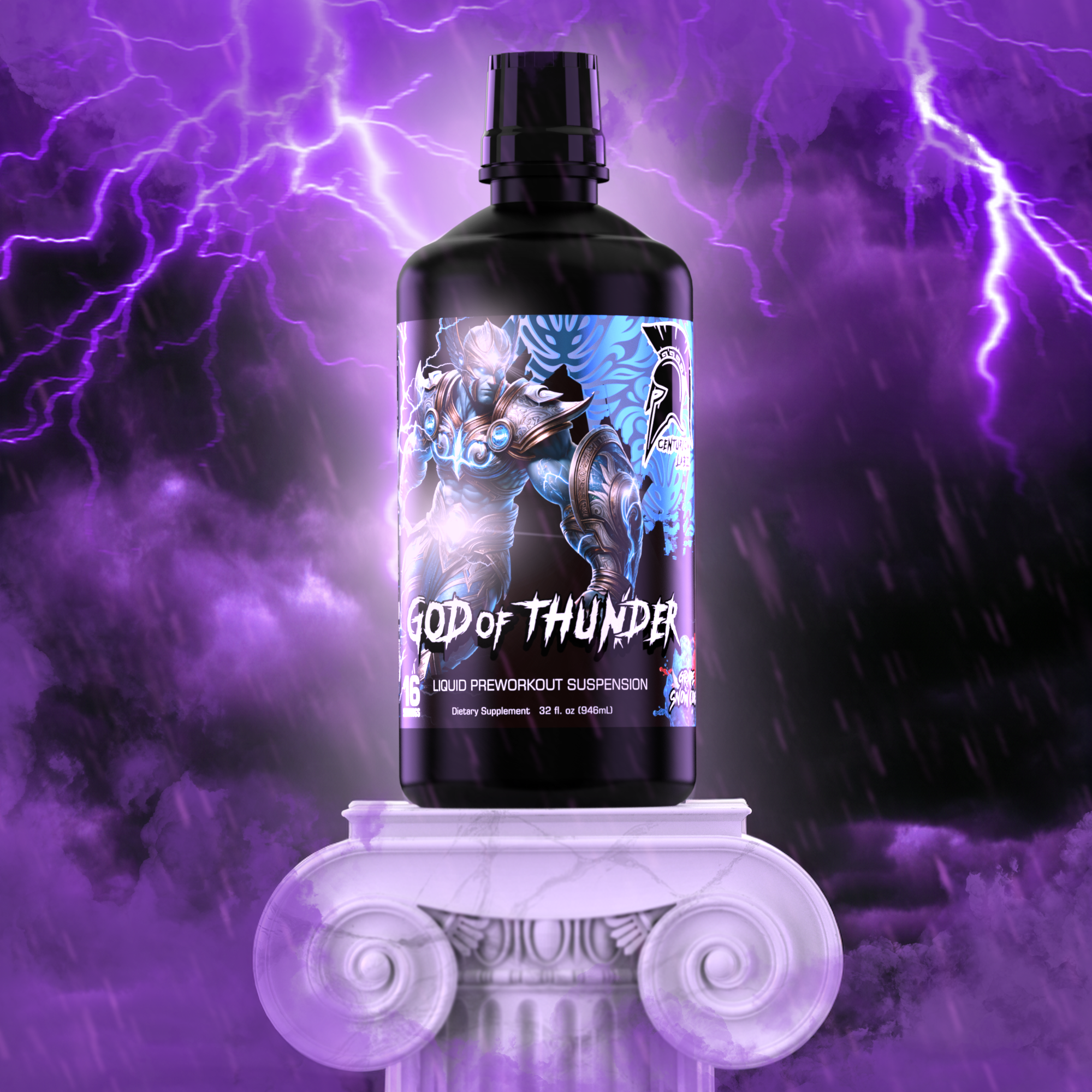
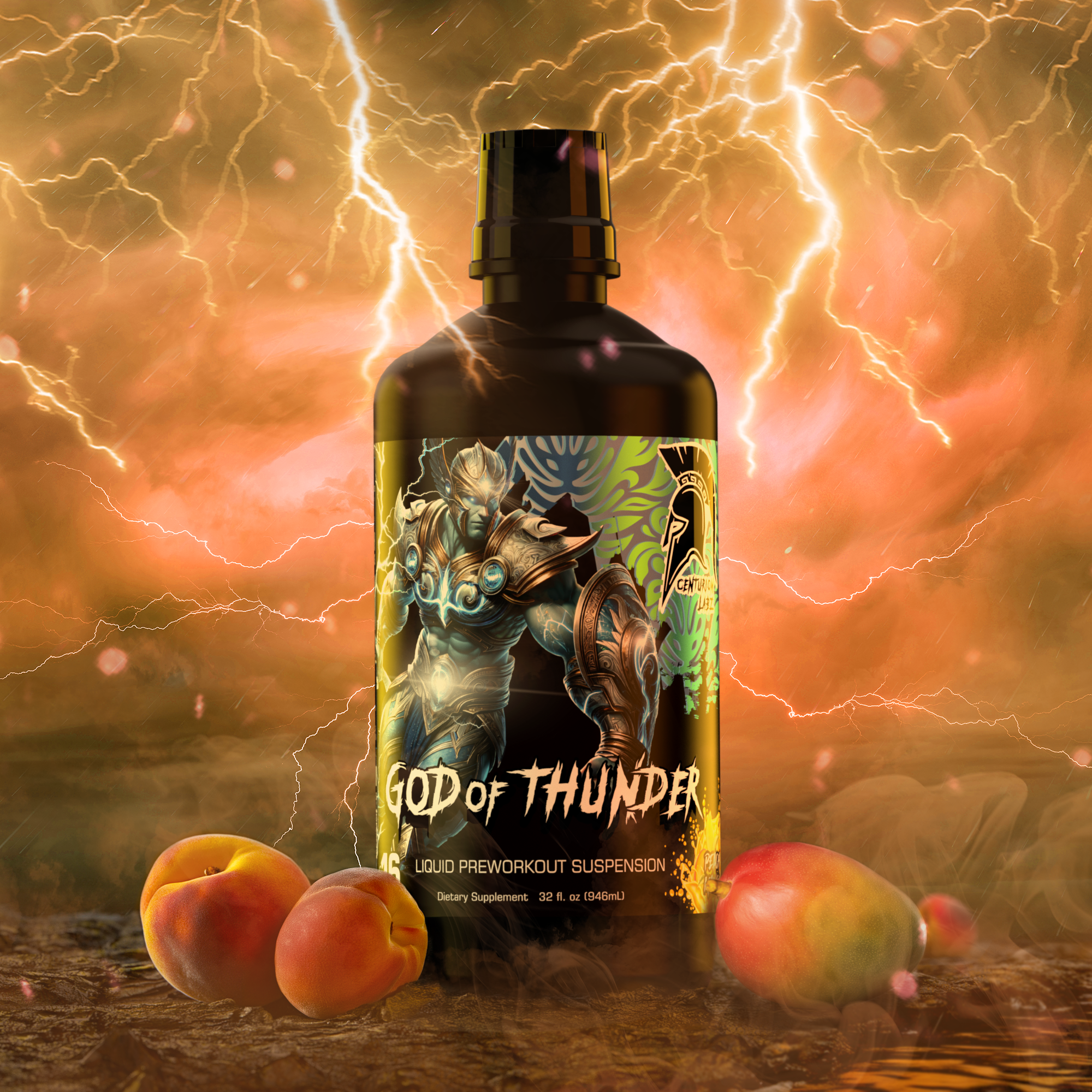
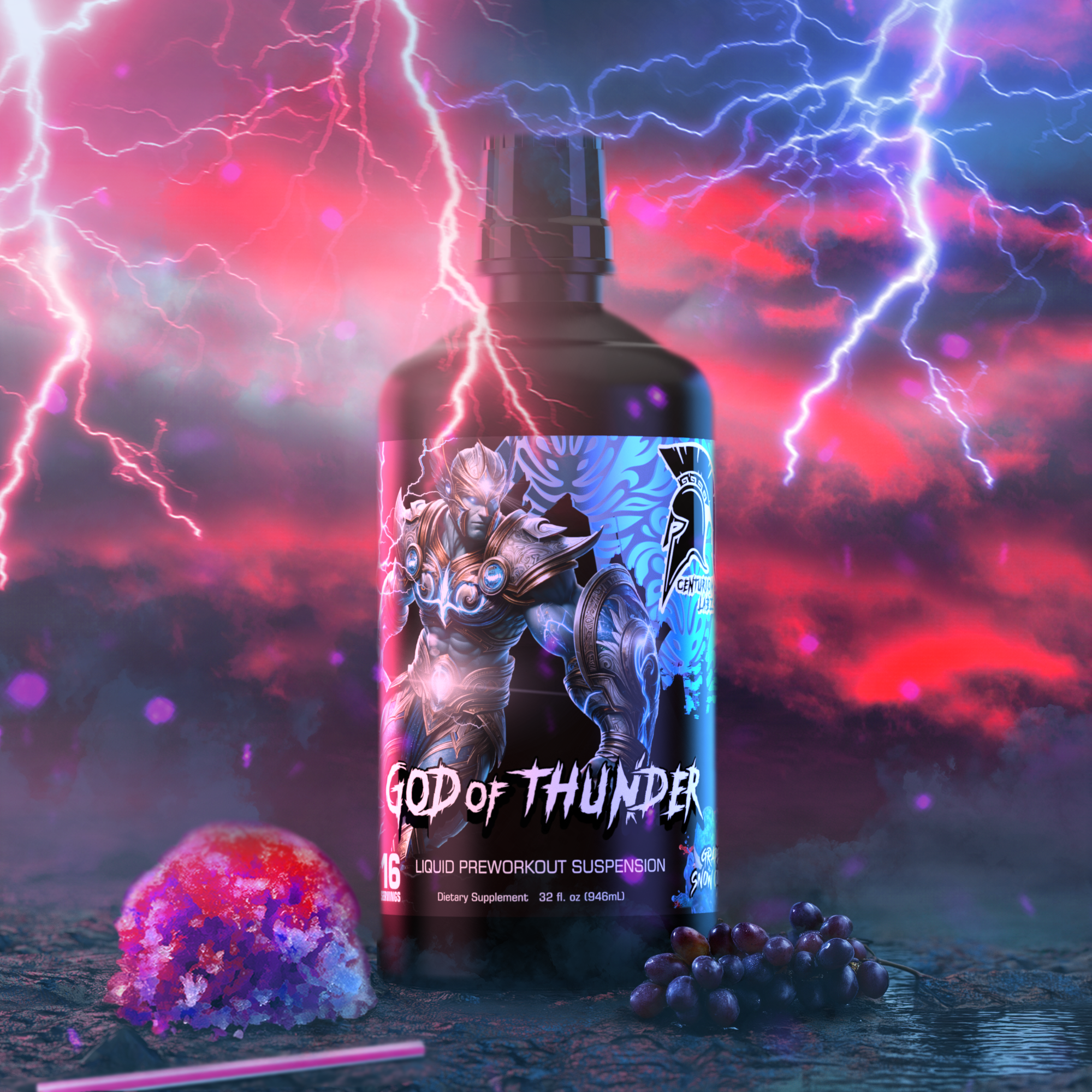

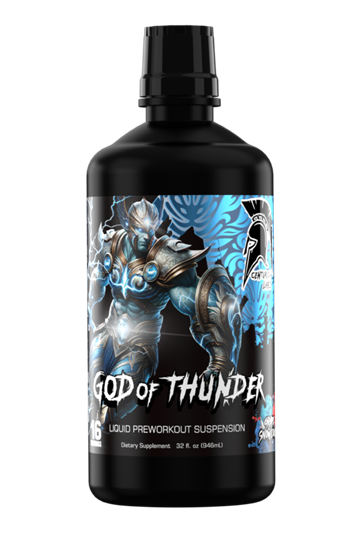


Comments and Discussion (Powered by the PricePlow Forum)